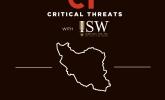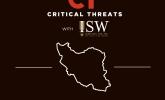Iran Crisis Update, November 2
November 2, 2022 - ISW PressIran is signaling its readiness to attack Saudi Arabia and possibly Erbil ostensibly in retaliation for the Shiraz terror attack but primarily for the alleged role of the US, Israel, and Saudi Arabia in stoking protests. The regime raised the red flag of Imam Hossein above the Shah Cheragh Mosque—the target of the terror attack—in Shiraz, Fars Province on October 30. The red flag represents revenge for an unjust death in Shia Islamic tradition. The regime takes down the flag once it has taken revenge. The regime raised the red flag last in Qom after the US killed Qassem Soleimani and before the Islamic Revolutionary Guards Corps (IRGC) conducted a ballistic missile attack on US forces in Iraq in January 2020. IRGC Telegram channels posted videos depicting a hypothetical Iranian drone attack on Saudi energy infrastructure on November 2.








